Identifying Termite Infestation: A Comprehensive Guide
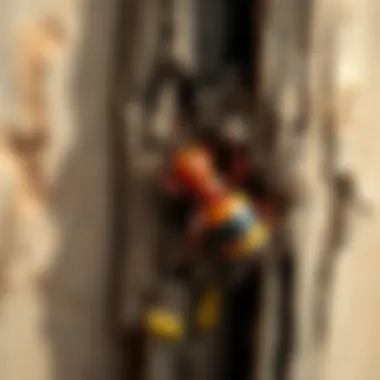
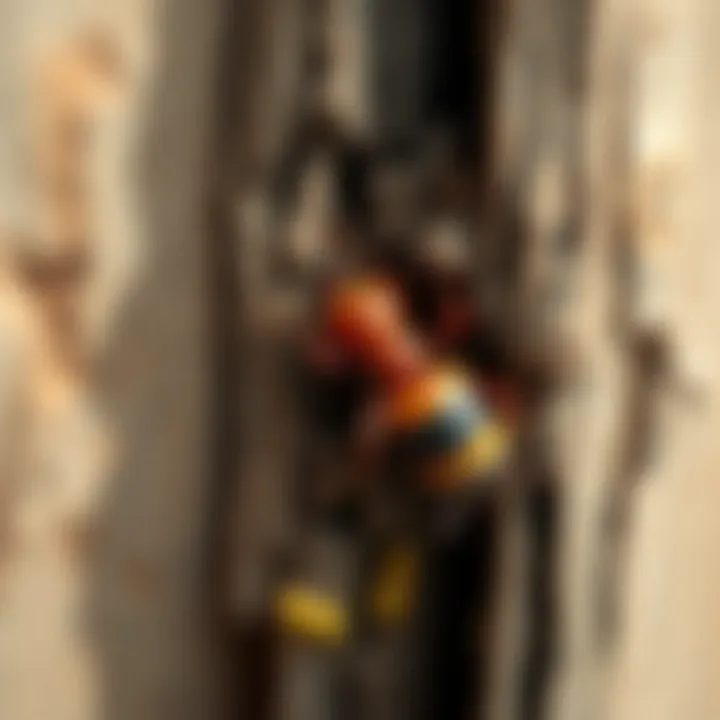
Intro
Identifying termite infestation is crucial for anyone who has a home, garden, or agricultural land. Termites, while often invisible at first glance, can cause havoc if left unchecked. This guide aims to provide a detailed exploration of how to spot these pests before they become a significant issue, catering specifically to agriculture farmers and enthusiasts who may face these challenges in their fields.
In the following sections, we will delve into the various signs of termite activity, identify the different types of termites that might invade your property, and discuss potential damages. Additionally, we'll explore practical measures that can be taken to prevent an infestation from taking root. Each topic carefully builds on the last, creating a comprehensive understanding of not only how to identify but also how to manage and mitigate the risks associated with termite infestations effectively.
Topic Overview
Definition and Importance
Termites are social insects that play a crucial role in the ecosystem by breaking down tough plant fibers, particularly cellulose. However, their appetite for wood and other plant materials can lead to severe structural damage in homes and crops. Understanding the significance of identifying termite infestations quickly can save both time and money for farmers and homeowners alike. Ignoring the early signs can lead to exponential growth of the infestation, resulting in significant repair costs or even loss of crops.
Brief History and Evolution
Termites have been around for millions of years, and their evolution has seen them adapt to various habitats across the globe. With over 2,500 species identified, their behaviors and habitats are diverse. While most termites prefer dead or decaying wood, some species can also be found in living trees, making the scope of potential infestations quite broad. Their ability to consume wood means that their presence has been noted as early as ancient civilizations—when structures were first built, concerns about wood-eating insects began.
Key Techniques and Innovations
In the face of termite challenges, several innovative approaches and techniques have emerged to help detect and manage infestations effectively.
Sustainable Farming Practices
Farmers are increasingly turning toward sustainable practices that can prevent termite damage. Planting species that are less attractive to termites, such as marigolds, can create a natural barrier.
- Using organic methods such as beneficial nematodes can help manage pest populations.
- Keeping mulch away from foundations prevents moisture retention, which is appealing to termites.
These methods are not only environmentally friendly but promote healthy soil and ecosystems.
Advanced Agronomic Technologies
New technologies have surfaced that assist in the early detection of termite activity. For example, moisture sensors in combination with integrated pest management systems can alert farmers to conditions favorable for termites.
- Remote monitoring devices can track moisture levels.
- Cameras and sensors can detect movement or damage patterns, providing critical information before the situation escalates.
Practical Applications
Understanding these aspects leads to real-world applications in managing termite infestations effectively.
Step-by-Step Guides
- Inspect Your Property Regularly: Look for signs of mud tubes, discarded wings, or hollow-sounding wood.
- Create Barriers: Implement both physical and chemical barriers designed to deter termites.
- Monitor Moisture Levels: Regularly check for leaks or damp areas that may attract termites.
- Enlist Professional Help: Sometimes DIY isn't enough; consider reaching out to local pest control experts.
Case Studies or Real-World Examples
In a notable case in Florida, a landscaping company managed to reduce termite infestations in residential areas by promoting the use of certain plants that repel these pests. Farmers reported significantly lower damage rates and healthier crops following these practices. Such examples serve to illustrate that effective management can result in healthier environments and reduced costs.
By staying vigilant and aware of the signs of termite activity, farmers can maintain healthier crops and protect their homes from potential damage.
Understanding Termite Behavior
Understanding the behavior of termites is crucial for anyone concerned about protecting their property from infestation. By grasping how termites live, interact, and thrive, homeowners and agricultural producers can proactively guard against these pests. Whether it's by improving preventive strategies or identifying signs of an infestation early, knowledge is a powerful weapon in the battle against termites.
One of the most important elements of termite behavior is their feeding habits. Termites predominantly consume wood. They play a significant role in the ecosystem by decomposing dead trees and other organic materials, recycling nutrients back into the soil. However, this beneficial behavior becomes a problem when they infest homes, barns, and crops, leading to potentially devastating damages. The more you know about how they feed, the better equipped you'll be to identify their presence and take necessary action.
Their social structure is another key aspect worth considering. Termites are social insects, meaning they live in large colonies or societies. This social setup includes various castes such as workers, soldiers, and reproductive members. Each caste plays a specific role that contributes to the colony's survival, which emphasizes just how organized these insects are. For example, the worker termites are the ones that do the eating and building, while soldiers protect the colony from threats. Understanding these roles can help you identify infestations more accurately, as different castes may leave distinct signs.
Moreover, being aware of their environmental needs is essential. Termites prefer moist environments and are often found in areas where moisture is readily available. This preference significantly impacts their behavior and distribution. Therefore, keeping your surroundings dry and well-maintained can deter these pests from making themselves at home.
"Knowledge of termite behavior is the first step in ensuring your home and crops remain protected from these destructive pests."
Useful resources for further reading on termite behavior include Wikipedia and Britannica.
Characteristics of Termites
Termites exhibit a range of characteristics that set them apart from other pests. They are small, but their impact can be massive. These insects typically are about 1/8 to 1/2 inch long and come in various colors ranging from white to brown. One of their defining traits is the presence of straight antennae, which can help differentiate them from ants, who have elbowed antennae.
Their bodies are soft and segmented, lacking the hard exoskeleton found in other insects. This structure allows them to work efficiently when tunneling into wood. A key characteristic is their ability to digest cellulose from wood, grass, and leaves, a trait that they share with few other organisms.
- Diet: Termites feed primarily on cellulose. Their unique enzyme capabilities allow them to break down this complex carbohydrate. You may find them gnawing on timber, root systems, and even paper products in your home.
- Coloration: While most termites are light in color, workers and nymphs usually appear pale, while soldiers have darker coloration due to the harder chitin of their exoskeletons.
- Reproduction: Reproductive termites, or alates, have a distinct appearance with their wings. They swarm mostly during warm, humid weather, and seeing these termites may indicate nearby colonies.
Social Structure and Roles
The social structure of termites is intricate and vital for the colony's survival. Understanding the roles within their community can provide insight into their behavior and potential risks they pose. The caste system includes:
- Worker Termites: These are the backbone of the colony, responsible for gathering food, maintaining the nest, and caring for the younger termites. Their tireless efforts are often unseen but critical.
- Soldier Termites: Armed with strong mandibles, soldier termites act as defenders of the colony. They protect against predators, particularly ants, and are characterized by their larger size and more robust body compared to workers.
- Reproductive Termites: This group includes kings and queens, whose primary role is reproduction. Crowning their appearance with wings during swarming season, they are vital in starting new colonies.
Each caste doesn't just serve a designated function but works in harmony to ensure the survival of the colony. This complex dynamic underscores the importance of swift identification during infestations. Upon spotting different castes like soldiers or swarmer alates, one can realize the potential extent of an infestation.
As you learn to identify these roles, you will enhance your understanding of their social organization, making it easier to spot trouble before it escalates.
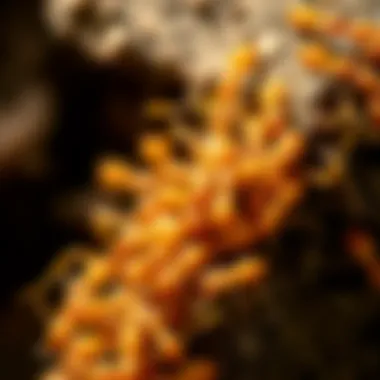
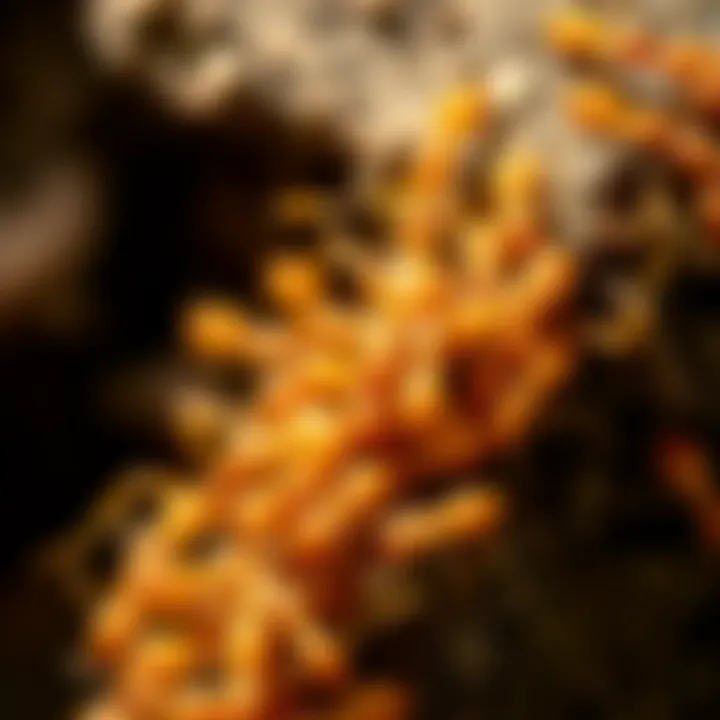
Types of Termites
Understanding the different types of termites is crucial for anyone dealing with pest management. Not only does it help in identifying the specific characteristics of the invaders, but it also guides in choosing the most effective treatment methods. Each type of termite has its own behaviors, nesting preferences, and associated damages. By recognizing these distinctions, you can better tailor your prevention strategies and treatments, ensuring a healthier environment.
Subterranean Termites
Subterranean termites thrive beneath the ground, making up the largest group of termites in the United States. This species is quite notorious for wreaking havoc on wooden structures due to their unique feeding habits. They live in colonies that can number in the millions, relying on moist soil to survive. Often, these critters create elaborate tunnels as they navigate through the ground, seeking food sources.
Their presence can be detected through mud tubes, often found emerging from the soil and leading directly up to wooden structures. If left unchecked, they can cause significant structural damage, which sometimes isn’t noticed until it’s too late. The signs may include hollowed-out wood or even crumbling beams. Regular inspections can help catch these signs before they escalate.
Drywood Termites
Unlike their subterranean cousins, drywood termites don’t require contact with the soil. Instead, they infest dry, undecayed wood, making them a major concern for homeowners. They tend to create small colonies and are often found in attics, roof structures, and wooden furniture. Typically, drywood termites are a bit trickier to identify, since they can silently consume wood for years without revealing substantial signs of their presence.
Common indicators of infestation include:
- Frass: Tiny droppings resembling sawdust.
- Tiny holes in wood surfaces, often found near infested areas.
- A sudden drop in the quality of wooden items.
Awareness of these signs is key for early detection and effective treatment.
Dampwood Termites
Dampwood termites, as the name suggests, favor wood that has high moisture content. You’ll typically find them in old, damp trees, especially in regions with high humidity. They are a bit less common than their subterranean and drywood counterparts, but they can still cause trouble, particularly in homes with poor ventilation or plumbing issues that lead to moisture accumulation.
Detecting dampwood termites can be challenging, especially since they tend to inhabit more remote areas, such as untreated wooden decks or fence posts. The damage usually appears as:
- Softened or decayed wood
- A notable increase in pest activity near rotting wood areas.
Taking proactive measures to fix any leaks and ensuring proper drainage can significantly reduce the risk of infestation.
Signs of Infestation
Understanding how to spot the indicators of termite infestation is essential for preventing larger issues down the line. Noticeable signs not only help homeowners take quick action but also aid farmers in identifying potential threats to their crops. Early detection can ultimately save considerable time and money. The importance of recognizing these signs cannot be stressed enough, as it empowers individuals with actionable knowledge that they can use in safeguarding their properties.
Visible Damage to Wood
Wood serves as the primary food source for termites, so visible damage is often the first and most tangible sign of an infestation. It’s critical to assess any physical harm to wooden structures, both in homes and agricultural settings. Certain manifestations will give you clear indicators of termite activity.
Surface Blisters
Surface blisters in wooden structures are often mistaken for water damage or simple wear. However, these blisters serve a distinct warning signal that termites may be munching away beneath the surface. Termites often create blisters as their tunneling disrupts the veneer layer of wood, causing it to bulge outward.
The key characteristic of surface blisters is their appearance. They often have a small, rounded shape and can vary in size, sometimes resembling a bubble that’s about to burst. For this article, it’s beneficial to highlight surface blisters as they can draw attention away from the actual problem that lies beneath. However, spotting these blisters alone isn’t enough; thorough inspection of the area surrounding them is crucial. This characteristic allows for easier identification, but often these blisters can go unnoticed unless the wood is closely examined.
Wood Tunnels or Galleries
Wood tunnels or galleries are another clear sign that wood may be under termite attack. These tunnels appear as a network of passageways within the wood, carved out by the relentless chewing of termites. Their presence indicates a more advanced level of infestation, where damage could be significant. The critical aspect here is that these tunnels compromise the structural integrity of the wood, and ignoring them could lead to severe problems.
This article highlights wood tunnels as they serve as a definitive evidence of infestation. They might not be immediately visible without further investigation but knowing to look for these internal signs can aid in early detection. The challenge is that these internal galleries are usually hidden, making them less apparent unless one has a trained eye.
Frass (Termite Droppings)
Frass, or termite droppings, might seem like quite an unappealing subject, but they are an important indicator of infestation. This small, wood-colored debris might be mistaken for sawdust or dirt. Frass is a clear indicator that termites have been feeding in the area. What sets frass apart is its appearance; when you notice small piles of this fine dust around wooden structures, it’s a direct sign of active termite feeding.
In the context of this article, frass is a pivotal sign to discuss. Not only does it signal that termites are present, but it can also indicate the type of termite based on the color and size of the droppings. Thus, monitoring for frass can yield essential insights into managing an infestation. However, one must be cautious, as not all wood damage results in frass accumulation, so it should always be coupled with other signs for comprehensive analysis.
Mud Tubes and Trails
Termites construct mud tubes for protection and travel between their colonies and food sources. These tubes usually appear along exposed walls or around the foundation of a property. Their presence signifies that termites are actively moving into and out of their environment, indicating not just the likelihood of infestation but also the scale of it. Being on the lookout for these tubes can help property owners realize the extent of the problem, as they are often an unmistakable marker of termite activity.
Swarms and Wing Discards
During certain seasons, termites swarm as part of their reproductive cycle. During these swarming events, you might notice discarded wings near windows or entry points—these wings are often left behind as they engage in establishing new colonies. Recognizing swarm activity is essential as it signifies that a colony is maturing, leading to the potential for a more widespread infestation. Therefore, knowing when swarming typically occurs within your geographical area adds another layer of vigilance.
Sounds of Termite Activity
Last but not least, while it may not be as overt as other signs, sounds like clicking or tapping noises can indicate active termites. These sounds are often made by soldier termites banging their heads against wood to signal danger to others in the colony. Being aware of these subtle auditory cues can provide an extra layer of oversight, especially in quiet areas of a home or farm where such noises may stand out. Listening closely can save you from stepping into a bigger mess down the road.
In summary, keeping an eye out for visible damage, mud tubes, swarms, and even subtle sounds can serve as your first line of defense against termite infestations. A proactive approach can mean a world of difference in protecting your home and livelihood.
Environmental Conditions Favoring Infestation
Understanding the environmental conditions that foster termite infestation is crucial for anyone wanting to safeguard their property, whether it's a home or a field. Termites can thrive under specific conditions, and recognizing these can help in taking preventive measures. The prevalence of moisture, the type of soil, and building practices can significantly influence the likelihood of termites creeping into your environment.
Moisture and Humidity Levels
Moisture is like the welcoming mat for termites. These pests thrive in damp environments, as they need water to survive. High humidity levels can create the perfect storm for termite colonies to flourish. Here are several elements to consider:
- Water Accumulation: Poor drainage systems can lead to accumulation around the foundation of buildings. If it's persistently wet, termites are sure to find a prime habitat.
- Settled Areas: Low-lying regions with excessive moisture can act as breeding grounds. Areas with irrigation or even stagnant water are particularly attractive.
- Indoor Humidity: Kitchens, bathrooms, and basements often have higher humidity levels. If not properly ventilated, these areas can become unsafe zones for infestation.
To keep termites at bay, it’s wise to invest in moisture-control systems, such as dehumidifiers and proper drainage setups. Regular checks for leaks can also make a world of difference. CDC has guidelines on how to maintain a healthy humidity level indoors for a healthier environment.


Wood Contact with Soil
Termites, particularly subterranean ones, are notorious for their ability to navigate through soil and then make a beeline for anything wooden. This situation calls for a keen eye when it comes to the placement of wooden materials. Consider the following:
- Direct Ground Contact: Any wooden structures such as decks, fence posts, or even landscaping timbers that touch the soil directly are highly vulnerable. This contact creates a direct pathway for termites to munch away.
- Soil Types: Some soils are more conducive to termite activity than others. Sandy soils, for instance, often have better drainage, which can support termite populations.
- Debris Accumulation: Organic materials, like fallen branches or wooden debris, that rest against the foundation, can also provide a buffet for these pests.
To mitigate risks, ensure that wooden structures are at least 6 inches above the soil. Using treated wood for construction can provide further defenses. The USDA recommends that homeowners maintain a clear zone between soil and wood to reduce the chances of infestation.
Proper moisture control and mindful wood placement can help keep termites at bay. Keep the enemy outside, where they belong.
Assessment Techniques
In the quest to combat termite infestations, adopting effective assessment techniques is essential. Recognizing the signs of infestation early can save homeowners from considerable expenses and stress down the line. Through proper assessments, one can gauge the extent of the intrusion and decide on the best course of action. Techniques used in assessing for termites can be grouped into two major categories: professional inspections and do-it-yourself (DIY) inspections. Both methods serve critical roles but cater to different needs and situations.
Professional Termite Inspections
When it comes to getting a grip on a termite issue, professional termite inspections are like having a seasoned detective on the case. Trained pest control experts come armed with experience and specialized tools that allow them to identify and understand the complexities of termite behavior and their habitats. A thorough inspection covers not just visible structures but also hidden areas that might otherwise go unnoticed, such as walls, crawl spaces, and even the inside of wooden beams.
The value of getting a professional to pinpoint problem areas lies in their expertise. They can spot warning signs that an untrained eye might miss. For instance, mud tubes – a classic marker of subterranean termites – require someone well-versed in termite identification to recognize them for what they are. Moreover, these professionals can provide you with extensive reports detailing the findings of their inspection, which can be beneficial when seeking treatment or filing insurance claims.
"A small leak can sink a great ship" — neglecting a termite problem can lead to disastrous structural damage over time.
DIY Inspection Guidelines
If you lean more toward a hands-on approach, a DIY inspection can be a practical choice. Inspecting your property regularly not only heightens your awareness of potential termite problems but also fosters a proactive attitude toward pest management. Here's how to effectively conduct DIY inspections in areas where termites typically thrive.
Inspecting Basements and Crawl Spaces
When assessing for termites, the basement or crawl space is often the first port of call. These areas generally slip under the radar, making them prime targets for infestations. Look closely for any unusual signs such as flaking paint, peeling wallpaper, or noticeable dampness; all of these can indicate a conducive environment for termites.
These spaces allow for a detailed examination of wooden structures. A key characteristic of inspecting these areas is their accessibility. By getting down low and checking out beams and joists, you can often catch termite activity before it spirals out of control. The unique feature here is the ability to access dark corners and crevices, where termites might hide, thus giving you a clearer picture of the infestation status.
However, crawling into cramped spaces can feel daunting. Safety should always be top of mind. Ensure there's adequate lighting, and don't hesitate to use a protective mask if you're dealing with mold or pests.
Checking Wooden Structures
Another important aspect of a DIY assessment involves examining wooden structures around your home. This could involve checking door frames, window sills, and any wooden decking you may have. The key characteristic here is the potential for damage that could go unnoticed for long periods, leading to costly repairs if not attended to.
One of the unique benefits of inspecting wooden structures is the ease of access. Unlike basements, most structures are visible and can easily be checked with a simple visual inspection. Look out for signs like hollow sounds when tapping or soft spots – these can be indicators of termite activity.
However, reliance solely on sight can be a disadvantage. It takes experience to differentiate between benign weathering and active termite damage. If there's any doubt, consulting with a professional could prove invaluable.
By honing these assessment techniques, whether through professional help or DIY efforts, you’re laying the groundwork for effective termite management. Remember, the sooner you identify an issue, the more tools you have at your disposal for addressing it.
Consequences of Untreated Infestations
When it comes to pest management, the significance of addressing termite infestations cannot be overstated. Ignoring these sly gnawers can lead to dire repercussions that affect not just the integrity of your property but also your financial standing. Let's delve into the inherent consequences that come with these uninvited guests roaming free in your abode.
Structural Damage
One cannot emphasize enough the potential structural damage that termites can wreak on a property. These pests are notorious for their insatiable appetite, targeting wood, paper, and even certain types of fabric. As they munch away in silence, the damage often goes unnoticed until it manifests in alarming ways. Here are a few key points worth considering:
- Weakening of Support Structures: Termites often invade walls, beams, and even the foundations of homes. This erosion of support structures can compromise the very stability of a building, making it unsafe for habitation.
- Hidden Damage: Even a thorough inspection might miss some of the damage. Commonly, termites operate behind walls and within hollowed timbers, leaving telltale signs only visible once significant damage occurs. This gradual deterioration can lead to costly repairs or, in severe cases, complete replacement of structural elements.
- Increased Renovation Costs: What may start as a minor infestation can spiral into expensive renovations. Replacing rafters or supporting structures could easily run into thousands of dollars if left unchecked.
"A stitch in time saves nine." Ignoring a small termite problem can lead to a much bigger financial burden down the line.
Economic Impact
The financial ramifications of termite infestations extend beyond just repairs. The wake of these pests often leaves a trail of hidden costs that can hit you where it hurts most - your wallet. Here’s how:
- Decreased Property Value: Homes prone to termite damage typically see their market value plummet. Buyers are wary of properties with a history of infestations, and you may need to adjust your asking price significantly.
- Insurance Repercussions: Many typical homeowner’s insurance policies don’t cover termite damage. Thus, if an infestation goes untreated, you might find yourself funding repairs completely out of pocket. This lack of coverage can lead to financial strain during already troublesome times.
- Loss of Income: For agricultural settings, the stakes are even higher. Infestations can harm crops and lead to reduced yield. Farmers might witness their profits dwindle as pests undermine their hard work in the fields. Overall, the ripple effect can lead to economic distress on both personal and community levels.
In summary, the consequences of untreated termite infestations span a wide spectrum from structural damages to significant financial losses. It’s paramount to be vigilant and proactive in your pest management efforts to mitigate these risks.
Preventive Measures Against Infestation
Addressing termite infestations before they start is far more effective than dealing with the aftermath of an invasion. Preventive measures are critical in safeguarding your property from these wood-devouring nuisances. Understanding how to keep termites at bay can save homeowners and farmers from devastating structural damage and economic loss, not to mention the headache that comes with eradication efforts. By focusing on moisture control, sealing entry points, and maintaining regular inspections, you can significantly lessen the chances of a termite infestation.
Moisture Control
Termites thrive in moist environments, making moisture control an essential aspect of preventative measures. When it comes to reducing the likelihood of termite infestations, keeping the surroundings dry is key.
- Identify and Repair Leaks: Inspect for leaky pipes, faucets, and roofs. Even minor leaks can create a paradise for termites.
- Improve Drainage: Ensure that your yard slopes away from your house to prevent water accumulation. Implementing proper drainage systems also reduces moisture levels.
- Ventilation: Increase airflow in crawl spaces and basements. Installing vents can help dissipate humidity, discouraging termite colonies from setting up shop.
- Use Dehumidifiers: In areas prone to high humidity, these devices can be a solid defense against moisture accumulation.
Effective moisture control not only helps keep termites at bay; it also contributes to overall home health by preventing mold and decay.
Sealing Entry Points
The next line of defense against termite invasion is sealing entry points. Those pesky critters can slip through the tiniest of cracks, so vigilance in sealing gaps is crucial.
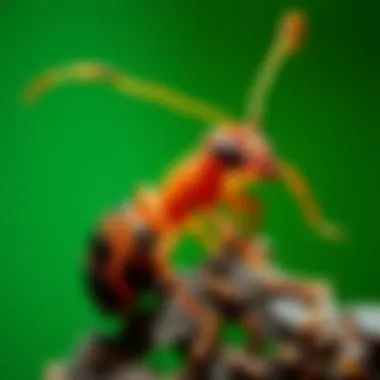
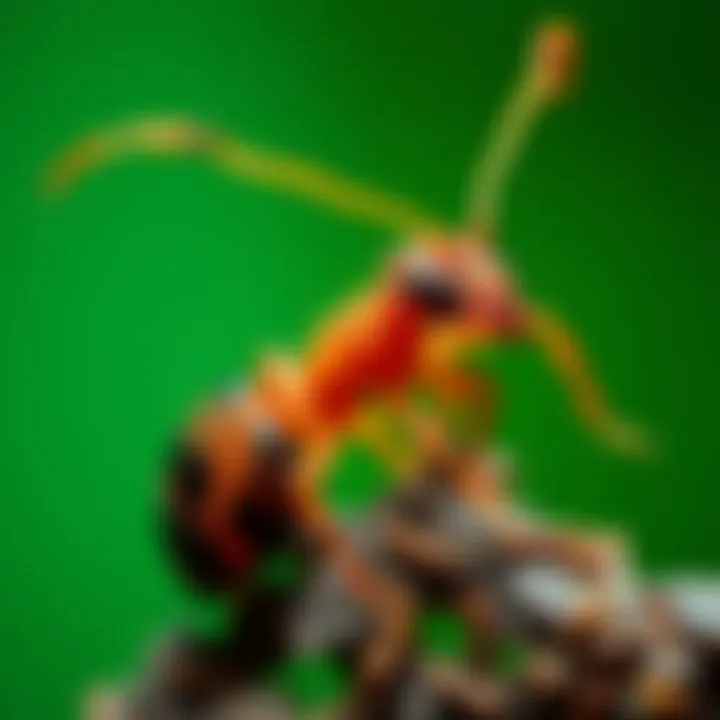
- Inspect Foundations and Walls: Look for cracks in your home's foundation or walls, particularly near pipes or wires. Seal these with appropriate materials like caulking or foam to create a barrier.
- Replace Damaged Wood: Any rotting or damaged wood should be replaced immediately. Not only does this reduce risks, but it also lends structural integrity to your home.
- Minimize Wood-to-Soil Contact: Use concrete or steel supports instead of wood when possible, especially at foundational levels. Termites often travel through soil to access wood, so limiting contact is a crucial step.
- Install Tight Fitting Doors and Windows: Ensure that doors and windows close snugly. Adding weather stripping can bolster your defenses against an unwanted termite welcome.
By fortifying your home against potential ingress points, you're actively reducing the chances of a termite colony finding a new home in your woodwork.
Regular Inspections
One of the best strategies for dealing with termites is regular inspections. By making a habit of checking for signs of infestation, you can catch any issues before they spiral out of control.
- Schedule Professional Assessments: Engaging a pest control professional to conduct an annual inspection can be invaluable. Their expertise can help identify subtle signs of termite presence.
- DIY Checks: Homeowners should conduct monthly checks for visible signs of termites. Look for mud tubes, discarded wings, or wood damage.
- Focus on High-Risk Areas: Pay special attention to crawl spaces, basements, and areas where wood contacts the soil. These hotspots are termite-friendly environments.
- Educate Yourself on Signs: Knowing the typical signs of termite activity can empower you to act quickly. Familiarize yourself with changes in your environment, such as soft spots in wood.
Regular inspections can act as an early warning system, allowing you to take immediate action if you discover a potential problem. This proactive approach can save both time and money in the long run.
"An ounce of prevention is worth a pound of cure."
Taking these preventive measures seriously can significantly reduce the likelihood of a termite infestation, ultimately providing peace of mind and a secure living or working environment. For more comprehensive pest management strategies, consider leveraging resources from trusted sources such as EPA.gov or University of Kentucky Cooperative Extension Service.
Treatment Options
Effectively treating a termite infestation is crucial in mitigating damage and preventing further issues in both residential and agricultural contexts. Ignoring treatment options can complicate the situation, leading to increased economic burdens and potential risk to structural integrity. Thus, understanding the various methods available for termite treatment is essential for any homeowner or farmer during their pest management efforts.
Exploring treatment options often falls into two primary categories: chemical treatments and non-chemical alternatives. Each category offers unique benefits and considerations.
Chemical Treatments
Chemical treatments are a common choice for termite control, striking a balance between immediate effectiveness and long-term protection. One widely used chemical is fipronil, a potent insect neurotoxin that disrupts the termite's nervous system. It's worth noting that such treatments form a barrier around the structure, often requiring professional application to ensure safety and efficacy.
However, while chemicals can provide swift results, it's essential to be aware of their environmental implications. Some products may pose risks to non-target species, especially in agricultural settings. Hence, assessing the situation carefully—considering factors like surrounding ecosystems—is vital before opting for chemical solutions.
Non-Chemical Alternatives
Non-chemical treatment options are gaining traction among environmentally-conscious farmers and homeowners alike, offering solutions that avoid the risks associated with pesticides.
Heat Treatments
Heat treatments have become increasingly popular as an effective alternative to chemical methods. This approach involves raising the temperature in infested areas to levels that are lethal to termites, typically above 120°F (49°C) for a minimum duration of one hour. The key characteristic of heat treatments is that they are a chemical-free solution, posing fewer risks to human health and non-target organisms.
The most beneficial aspect of heat treatments is their ability to penetrate deeply into wood, eliminating hidden termite nests and life stages effectively. However, it is crucial to highlight that heat treatments may not be suitable for all materials and structures due to the risk of damage from high temperatures. Landowners should consult professionals who specialize in this method to assess the feasibility of heat treatment for their specific cases.
Boric Acid Applications
Boric acid applications present another viable non-chemical option. This naturally occurring mineral is effective against termites when ingested, disrupting their digestive system and leading to dehydration. The unique feature of boric acid lies in its relatively low toxicity to humans and pets, making it a safe choice for indoor pest control.
Interestingly, boric acid can be applied as a bait or mixed with other substances to enhance its effectiveness. However, it's critical to consider the persistence of the application—reapplication may be necessary after intervals, especially in high-moisture environments where efficacy could diminish.
In summary, whether opting for chemical or non-chemical treatments, a balanced understanding of effectiveness, safety, and environmental impact is necessary when addressing termite infestations. Each method carries its strengths and limitations, making it essential for the reader to consult with professionals before making a definitive choice. This approach not only aids in proper management but also contributes to sustainable farming and living practices.
Consultation with Professionals
When faced with the daunting task of identifying and dealing with a termite infestation, consulting with professionals becomes a vital step. Termites can be quite sneaky, often hiding their activities behind walls or beneath floors until substantial damage has been done. Professionals possess the expertise and experience to pinpoint the specific type of termite invaders and evaluate the extent of the infestation.
Choosing a Pest Control Service
Selecting the right pest control service is crucial. You should look for licenses and certifications, as these can serve as markers of reliability. Asking for referrals from fellow farmers or checking online reviews can provide insight into the reputation of a service. An important element is whether the company offers customized plans tailored to specific pest needs. Understanding their approach and techniques is equally essential because different termite species may require various treatment methods.
A reputable pest control service should also provide an initial consultation, which often includes a thorough inspection of your property. This inspection will help determine whether termites have invaded your space and how severe the situation is. After the evaluation, they should present you with a detailed report that outlines the findings and offers multiple treatment options.
Understanding Treatment Costs
When it comes to treatment costs, those can vary widely based on a few factors. The type of termite, the size of the infestation, and the treatment method all influence the price. Chemical treatments may range from a few hundred dollars to more significant amounts depending on the severity. Non-chemical treatments, though potentially expensive upfront, can be worth it in the long run due to their effectiveness and lower environmental impact.
It's wise to gather quotes from several pest control services to get a clearer picture of the costs involved. However, don’t let price be the only deciding factor; effectiveness, guarantees, and follow-up services are equally important. If the price seems too good to be true, it's likely that the service may cut corners, which could lead to recurring infestations.
Consulting with a pest control professional is not merely about resolving an infestation but also about understanding how to prevent it from becoming a threat in the future.
In summary, engaging with professionals brings a layer of assurance that DIY methods often lack. Whether it’s choosing the best pest control service or understanding what the treatments will cost, having experts on your side can streamline the process and provide peace of mind.
Ongoing Management and Monitoring
Managing a termite infestation isn't just about identifying it and treating it when it arises; it also encompasses a robust approach to ongoing management and monitoring. Consistent vigilance in monitoring can prevent minor issues from escalating into major disasters. In agricultural settings, where crops are involved, it becomes even more critical. Systems in place to track termite activity not only protect structures but also ensure the sustainability of farming operations. By developing a comprehensive strategy, we can fend off these pests and greatly improve overall conditions.
Establishing Monitoring Systems
To effectively manage termite populations, establishing a rigorous monitoring system is paramount. This system typically includes both physical inspections and technological aids. Physical inspections should be scheduled regularly, focusing on high-risk areas such as wooden structures, foundations, and soil near gardens.
- Visual Checks: Look for signs like mud tubes, frass, or any wood damage. Making a habit of these checks fosters an early detection mentality.
- Moisture Sensors: Excess moisture invites termites. Installing moisture sensors in critical areas like basements or around potted plants can be beneficial in combating conditions perfect for infestations.
- Bait Stations: Strategically placing bait stations around the property can trap termites before they infiltrate a structure. Regularly inspecting these stations will give insights into termite activity levels.
- Professional Services: Depending on the extent of the infestation threat, enlisting professional pest control services can provide deeper insights. They often have the tools and expertise to assess risks accurately, ensuring all is well.
Establishing these systems might take time and investment, but compared to the cost of damage and treatment, it's a small price to pay. Consistency is key; even missing one inspection can lead to unforeseen complications.
Staying Informed on Best Practices
To keep up with effective pest management, staying informed about best practices is crucial. Termite management techniques constantly evolve, and what worked a decade ago might not hold up against today's elusive termites. Here are some guidelines to ensure you remain ahead:
- Research New Treatments: New non-chemical options are emerging regularly. Keeping an eye on literature from sources like Britannica or peer-reviewed agricultural journals helps in adapting best practices.
- Community Involvement: Tap into local initiatives related to agricultural management. Engaging in discussions on platforms like Reddit can provide insights from fellow farmers facing similar challenges.
- Workshops and Training: Participating in workshops offered through agricultural departments or universities enhances knowledge. Meeting experts and fellow enthusiasts could spark innovative ideas.
- Stay Updated on Regulations: Regulations around pest management can change. Keeping abreast of new laws from local governmental websites can help prevent potential legal issues.
Staying informed removes the guesswork. Knowledge is empowering, and equipped with the necessary information, farmers and property owners can make wise decisions, ensuring the longevity and health of their crops and structures.
"An ounce of prevention is worth a pound of cure." - Benjamin Franklin
In termite management, this saying rings especially true. Commit to ongoing monitoring and education so that those pesky insects don't catch you off guard.



